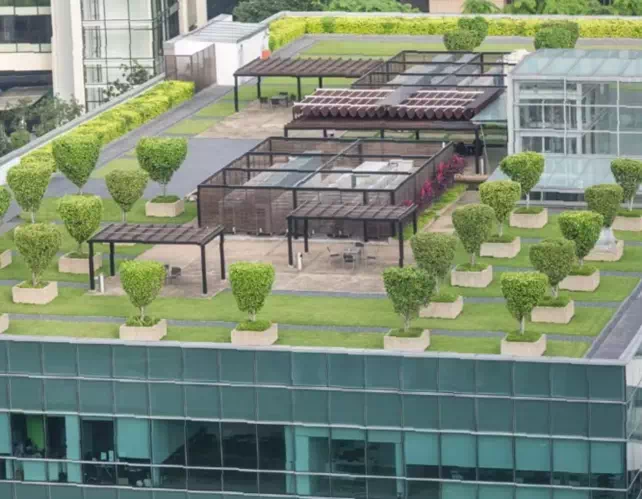
Blog
Incentivizing Green Roof adoption through insurance
20th of February 2024

© Chuttersnap from Unsplash
Climate change has severe impacts on human well-being. For example, 1.2 billion humans are currently exposed to severe flood risks, and the number is increasing (WWAP, 2018). Climate change, combined with urban growth, has also numerous additional adverse consequences such as the Urban Heat Island effect, air and water pollution, biodiversity loss, etc. Addressing these interconnected challenges requires restoring ecosystems and their services - also called ecosystem services.
Nature-based solutions (NBS) have emerged in the past decades as climate adaptation measures designed to provide benefits for human well-being as well as for supporting biodiversity. NBS is the umbrella term for all ecosystem-based approaches designed to tackle these societal challenges. They provide multiple co-benefits, and are therefore often considered as more cost-effective than grey infrastructures (Kabisch et al., 2017).
NBS can span many spatial scales. They can be the restoration and conservation of ecosystems, such as rivers, wetlands or coastal ecosystems or smaller scale urban infrastructures such as urban forests, bio-retention ponds and bioswales. . One example of NBS that offer multiple co-benefits in dense urban areas are green roofs.
Green roof initiative by Interpolis
Green Roofs are roofs that are partially or completely covered by vegetation and a growing medium. They can either have a small layer of vegetation - usually sedum and moss - in which case they are dubbed extensive Green Roofs, or they can be designed as "intensive Green Roofs", with a thicker of vegetation, by including small trees and shrubs.
They are structural improvements to buildings designed for improving their sustainability. This means first and foremost that they provide various benefits to homeowners, mainly by 1) improving building thermal insulation, leading to associated energy savings, and by 2) increasing the roof structure protection against weather elements (rain, UV) – and thus its overall lifespan. Green Roofs can also be designed to store rainwater, in order to mitigate flood risks - and are thus often labeled "Blue-Green Roofs".
Green roofs provide also co-benefits like their aesthetic amenities, as well as their recreational amenities, when they are accessible by residents. Additionally and especially when implemented alongside ecological corridors and in connection to each other, they can provide increased habitat and support biodiversity.

© Green roofs designed to provide recreational amenities. Source: Interpolis
The ongoing first pilot study of the PIISA project focuses on an innovative climate adaptation strategy initiated by Dutch insurer Interpolis. Interpolis has taken up a series of policies aimed at stimulating home insurance policyholders to adopt green roofs, through various incitation mechanisms. Interpolis offered in the past premium discounts of up to 7% to the home insurance premium of their customers upon installing green roofs. This policy now extends to all safety practices, not only green roofs. They also set up information campaigns, green roof themed local events to facilitate communication among neighbours, etc. The rationale behind this strategy for Interpolis is to stimulate Green Roof adoption at a large scale, as individual climate change adaptation and home protection measures. It has potential to reduce home insurance payouts in the future.
The ongoing first pilot study of the PIISA project in the Netherlands aims at 1) evaluating Green Roofs as adaptation measures, 2) analysing the effectiveness of incitation mechanisms – including those tested by Interpolis, and 3) providing insights into the potential barriers and enablers of green roof adoption.
To address these research questions, we will develop a series of economic analysis, employing surveys and economic experiments. A Discrete Choice Experiment will be developed and addressed to Dutch homeowners in order to estimate preferences for various Green Roofs, as well as to monetise the various co-benefits of Green Roofs. The monetised co-benefits estimates will then be integrated alongside cost estimates within the framework of cost-benefit analyses of Green Roofs. The distribution of Green Roof costs and benefits among various stakeholder groups (e.g. insurers, public institutions, homeowners, other residents, ...) is also a focal point.
These surveys also aim at investigating instruments to facilitate the adoption of these NBS among building owners. Economic experiments aimed at building owners will aim at testing the effectiveness of incentives such as information campaigns or premium discounts into the decision of adopting green roofs.
Another objective of this study is to identify public-private partnerships and explore sustainable finance arrangements that can incentivize investments in green roofs. Ultimately, the pilot aims to develop business models that can be adopted by the European insurance industry to scale up nature-based solutions for climate risk, benefiting both insurers and their clients.
Lessons learned in this Pilot will lead to providing recommendations for scaling up of green roofs. Moreover, the costs and benefits of green roofs will be assessed at a larger scale in PIISA for other areas of the EU (the Boreal and the Mediterranean regions).
Authors
- Dr. Georges Farina, from "Stichting VU - Institute for Environmental Studies (IVM)"
References
Cohen-Schacham, E., Walters, G., Janzen, C., & Maginnis, S. (2016).
Nature-Based Solutions to address global societal challenges.Kabisch, N., Korn, H., Stadler, J., & Bonn, A. (2017).
Nature-based solutions to climate change adaptation in urban areas: Linkages between science, policy and practice.WWAP. (2018). World Water Development Report 2018: Nature-Based Solutions for Water. In UN Water Report